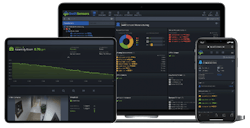Remote work isn’t only for office workers. With IIoT-connected sensors installed on their products, equipment manufacturers can provide faster, safer customer service even without making a service call. That can improve customer experience at a time when B2B needs to meet customer’s increasingly high expectations.
At the same time, manufacturers can spend less to provide that improved service, as evidenced in the McKinsey & Company report, “The productivity imperative in services,” which found that remote service technology can cut the cost of field service by 10% to 40%, with more savings among “machinery OEMs with a large installed base.” Here’s how remotely accessible data can help industrial manufacturing CSRs to solve customer issues over the phone or in a videoconference.
Remote eyes and ears in the field
Manufacturers can add a variety of secure wireless sensors to their equipment and other products. The most common and useful for industry are remote vibration sensors and remote temperature sensors. Vibration sensors show whether a motorized piece of equipment is operating within its optimal range, while temperature sensors can raise an alert if equipment is overheating. This data is especially helpful when it’s paired with a video camera, to show if the issue might be caused or exacerbated by the way customers are using the equipment.
This sensor-based approach to service also makes it easier to deliver highly personalized help based on the customer’s unique situation. Personalization, ease and speed are three key areas of customer experience. However, Walker’s Customers 2020 B2B survey found that only 9% of B2B customer-service professionals say their companies are very effective at delivering personalized customer experiences (www.controldesign.com/walker). And only 7% say they’re good at delivering easy experiences.
Faster diagnostics
What does this look like in practice? As an example, if a customer contacts customer service because they’re having issues with their CNC router, the data from the vibration sensor on the router can show the service agent if the machine is operating outside its ideal range. If so, that can mean that the machine is under too much physical force.
With the addition of a video feed, the agent can watch the customer use the router and may be able to see that the customer is using materials that are too tough for the router’s horsepower. Or the agent may see that there’s a mechanical issue with the router that needs a field service call.
Faster time to resolution
If the issue is as simple as selecting a lighter weight material to match the router’s capabilities, the problem can be resolved during the call. The customer doesn’t have to wait for a service technician to come out and have the technician explain the problem again, and the customer can resume operations as soon as the issue is corrected at the customer end. Faster problem-solving is a big advantage, because only 8% of customer-experience professionals say their B2B companies meet customer expectations for speed.
Even if a service call is required, having data to review can help the technician to identify the cause of the problem in advance, or at least narrow the list of possibilities. That allows them to make sure they bring the right tools and parts with them on the call, so they can make the repair quickly, without having to leave to get what is needed. The customer’s equipment is back online faster, and the technician spends less time on each call.
Better service coverage even when short-staffed
When field technicians only have to make calls for issues that can’t be solved remotely, and when their service calls go faster because they’re better prepared, companies can maintain a high level of service even if they’re short-staffed due to employee illness and quarantines. This can translate into a better experience for employees, as well as customers, because there’s less stress around repair delays.
Safer service calls
Remote sensors on industrial equipment also make it easier for manufacturers and their customers to maintain physical distancing for safety. The fewer times a field technician has to show up in person, the fewer opportunities for close contact and exposure. Remote diagnostics and problem-solving can also decrease the amount of time that technicians need to spend in risky environmental conditions such as extreme heat or cold.
Fewer unplanned service issues
Over time, the data from each piece of equipment—and from all the pieces of equipment in a product line—can create a database that contains the history of the machinery’s functioning. Combining this data with algorithms that are trained on the equipment’s life span and maintenance needs, manufacturers can offer the customers predictive-maintenance (PdM) capabilities that reduce unplanned downtime.
For example, a maker of industrial motors can implement PdM on its products so that customers only need maintenance when it’s necessary, based on real-world usage and conditions. That saves everyone the time that would otherwise be set aside for schedule-based preventive maintenance, while also avoiding the disruption of unplanned downtime due to motor breakdowns.
It takes time to collect enough data to build an effective PdM program, but the manufacturer still benefits from the stream of real-time data for remote customer service and diagnostics in the meantime.
A better overall experience
Remote sensors are a low-cost way for manufacturers to gather more data on their products in the field, deliver faster and safer customer service, reduce field service costs and reduce the time required to maintain machinery. Taken together, the benefits of data monitoring create a better customer experience by increasing personalization and ease of service and solving customers’ problems faster.
ALSO READ: All the monitoring in one sensor
About the Author
Ray Almgren
Swift Sensors

Leaders relevant to this article:

